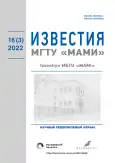Prediction of energy and cavitation characteristics of high specific speed Francis hydraulic turbines
- 作者: Zharkovskiy A.A.1, Schur V.A.2, Mohammad O.1
-
隶属关系:
- Peter the Great St. Petersburg Polytechnic University
- Peter the Great St.Petersburg Polytechnic University
- 期: 卷 16, 编号 3 (2022)
- 页面: 225-234
- 栏目: Hydraulic and pneumatic systems
- URL: https://journals.rcsi.science/2074-0530/article/view/126629
- DOI: https://doi.org/10.17816/2074-0530-105208
- ID: 126629
如何引用文章
全文:
详细
BACKGROUND: Cavitation is a phenomenon that occurs in vane hydraulic machines: pumps, hydraulic turbines, when the pressure in a certain area of the flow reaches the level of saturated steam pressure. Its occurrence depends on the design and mode of operation of the hydraulic turbine. In order to design a hydraulic turbine with high cavitation qualities, it is necessary to be able to reliably predict this phenomenon.
AIMS: The article describes approaches to modeling the operation of Francis hydraulic turbines based on the ANSYS software package.
METHODS: Using quasi-3D methods was modeled turbine blade system with 75 meters head. Hydrodynamic computation carried out in single-phase and two-phase formulations using the ANSYS CFX package.
RESULTS: The design of a flow path Francis turbine 3D solid model with a specific speed coefficient ns =283 has been completed. The flow part of the hydraulic turbine includes a spiral case, a stator, a guide vane, an impeller and a draft tube. Computational modeling of the flow of a single-phase viscous fluid in a hydraulic turbine in different modes was carried out to construct a universal characteristic. The optimal efficiency is found and the flow characteristics are calculated. The losses in the elements of the flow part of the hydroturbine under various operating modes are determined, the zone of optimal operation is found. The cavitation flow is calculated using a two-phase flow model (water-steam). For both sides of the impeller blade, a pressure distribution was obtained, which can be used to judge the possibility of cavitation in areas where the pressure of the water column is less than the vaporization pressure. The value of the critical cavitation coefficient for the three most unfavorable modes was determined, and the dependence of the efficiency on the cavitation coefficient was constructed. The area occupied by steam on the blade during cavitation flow is visualized, its area is determined relative to the surface area of the blade.
CONCLUSIONS: The designed hydraulic turbine has good energy and cavitation qualities, confirmed by the calculation. This version of the hydroturbine can be used as the initial one with further optimization of the blade system and elements of the flow path, to improve the energy and cavitation qualities.
作者简介
Aleksandr Zharkovskiy
Peter the Great St. Petersburg Polytechnic University
Email: azharkovsky@gmail.com
ORCID iD: 0000-0002-3044-8768
SPIN 代码: 3637-7853
Professor, Dr. Sci. (Tech.), Professor
俄罗斯联邦, 29 Politekhnicheskaya street, 195251, Saint PetersburgVasiliy Schur
Peter the Great St.Petersburg Polytechnic University
Email: tshur_va@spbstu.ru
ORCID iD: 0000-0002-9816-4323
SPIN 代码: 3626-5109
Cand. Sci. (Tech.), Associate Professor
俄罗斯联邦, 29 Politekhnicheskaya street, 195251, Saint PetersburgOmran Mohammad
Peter the Great St. Petersburg Polytechnic University
编辑信件的主要联系方式.
Email: omran3.m@edu.spbstu.ru
ORCID iD: 0000-0001-9284-171X
SPIN 代码: 5292-5533
post graduate
俄罗斯联邦, 29 Politekhnicheskaya street, 195251, Saint Petersburg参考
- Bunea F, Ciocan GD, Bucur DM, et al. Hydraulic Turbine Performance Assessment with Implementation of an Innovative Aeration System. Water. 2021;13(18):2459. doi: 10.3390/w13182459
- Patel K, Desai J, Chauhan V, et al. Development of Francis Turbine using Computational Fluid Dynamics. In: The 11th Asian International Conference on Fluid Machinery and The 3rd Fluid Power Technology Exhibition, November 21–23, 2011, IIT Madras, Chennai, India. Chennai: IIT Madras; 2011. doi: 10.13140/2.1.2177.4402
- Shukla MK, Jain R, Prasad V, et al. CFD Analysis of 3-D Flow for Francis Turbine. MIT International Journal of Mechanical Engineering. 2011;1(2):93-100.
- Topazh G.I. Lopastnye gidromashiny i gidrodinamicheskie peredachi. Osnovy rabochego protsessa i rascheta gidroturbin. St. Petersburg: Izd-vo Politekh. un-ta; 2011. (in Russ).
- Celebioglu K, Altintas B, Aradag S, et al. Numerical research of cavitation on Francis turbine runners. International Journal of Hydrogen Energy. 2017;42(28):17771-17781. doi: 10.1016/j.ijhydene.2017.03.180
- Zgolli R, Ennouri M, Kanfoudi H. Modeling of cavitation in hydraulic turbomachinery. 16th International Symposium on Transport Phenomena and Dynamics of Rotating Machinery, Apr 2016, Honolulu, United States. 2016:ffhal-01894392f.
- Zharkovskiy AA, Grachev AV, Shumilin SA, et al. Matematicheskie modeli rabochikh pro-tsessov lopastnykh gidromashin. St. Petersburg: Izd-vo Politekh. un-ta; 2011. (in Russ).
- Topazh GI. Lopastnye gidromashiny. Vybor osnovnykh parametrov i elementov protochnoy chasti reaktivnykh gidroturbin. St. Petersburg: Izd-vo Politekh. un-ta; 2006. (in Russ).
- Barlit VV. Gidravlicheskie turbiny. Kiev: Vishcha shkola; 1977. (in Russ).
- Pugachev PV, Svoboda DG, Zharkovskiy AA. Raschet vyazkogo techeniya v lopastnykh gidro-mashinakh s ispolzovaniem paketa ANSYS CFX. St. Petersburg: Izd-vo Politekh. un-ta; 2016. (in Russ).
- Moukalled F, Mangani L, Darwish M. The Finite Volume Method in Computational Fluid Dynamics. An Advanced Introduction with OpenFOAM and Matlab. Berlin: Springer; 2016.
- Gohil PP, Saini RP. Numerical Study of Cavitation in Francis Turbine of a Small Hydro Power Plant. Journal of Applied Fluid Mechanics. 2015;6(1):357–365. doi: 10.18869/ACADPUB.JAFM.68.224.24080
- Panov LV. Chislennoe modelirovanie kavitatsionnykh techeniy vyazkoy zhidkosti v gidro-turbinakh. [dissertation] Avtoref. dis. ... kand. tekh. nauk. Novosibirsk; 2014. (in Russ).
补充文件

























